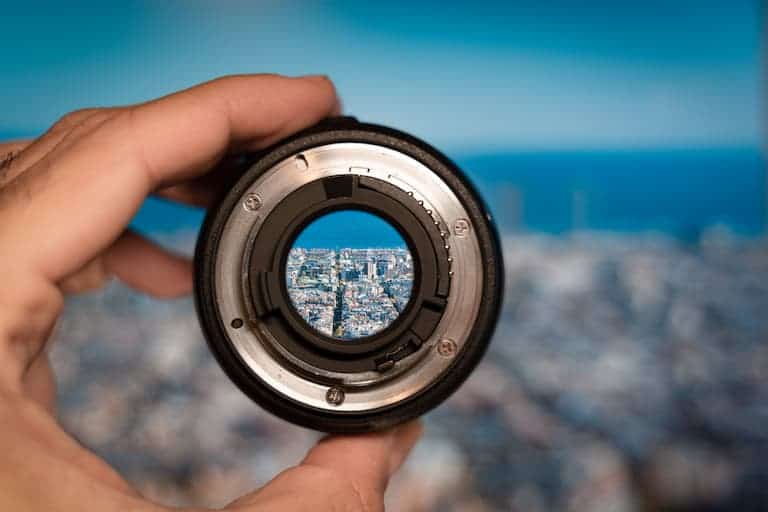Photography is a talent that can be used to create beautiful images of all different subjects. Many people have made the art their entire profession and have built successful careers in taking photos. One of the most critical pieces of equipment for photographers is their zoom lens.
A zoom lens can see infinitely far; however, the size of the subject in the photo will get smaller the further away from the lens they are. Zooming in too far can also cause the photo to lose quality and appear blurry or grainy.
Lenses are typically categorized by their focal length, which determines how much of a scene can be captured. This article will explain the different types of camera lenses and how zoom lenses’ focal lengths differ.
Table of Contents
Zoom Lenses Can See Extended Distances
Zoom lenses are used to capture photos of subjects at far distances. These lenses provide an adjustable focal length within the lens. Essentially, the photographer can change the focal length of the lens without physically having to move closer or further from the subject they’re shooting. This is helpful compared to a prime lens, which only has one focal length per lens.
Zoom Lenses Work for Various Photography Genres
Photographers tend to love zoom lenses because they can use them for a wide array of different types of photography. They can be used to capture anything from people in a studio to wildlife in the Amazon rainforest. The most popular types of zoom lenses are the standard zoom lens and the superzoom lens.
Zoom lenses allow photographers to capture what they want to within the frame. If there are unwanted objects or people in the frame, the photographer can change the focal length to crop them out. These lenses also provide a photographer with the ability to enlarge or magnify their images.
Zoom Lenses Preserve Quality of Distant Subjects
In the early years of the zoom lens, it was challenging to find one with the same visual resolution as a prime lens. Now that technology has advanced, however, there are zoom lenses that create a resolution that can compete with the resolution of a prime lens.
Another significant benefit of zoom lenses is their ability to prevent a photographer from having to use digital zoom post-shoot. The quality of the image is maintained through the use of optical zoom instead of digital zoom.

Understanding Focal Length
The focal length of a lens tells us the angle of view and the magnification of the lens by taking the measurement (in millimeters) from the optical center—or the spot where light rays converge—and the digital sensor of the lens. The digital sensor is made up of a 35mm piece of film and is placed at the camera’s focal plane to capture the image.
Camera lenses are labeled and categorized by their respective focal lengths. Basically, the smaller the number, the more scenery the lens will be able to capture. Therefore, larger focal lengths result in a narrower view of the scenery.
Focal Length Affects Essential Photo Qualities
The focal length of the camera lens affects images in four different ways.
The following factors of image quality are affected by a lens’s focal length:
- Field of view
- Depth of field
- Perspective
- Image shake
Below we will cover each of these components of image quality and how a zoom lens might impact their contribution to a photo.
Field of View Affects Range Captured
Field of view is used to determine what parts of the scenery are captured by the camera. Wide angle lenses use shorter focal lengths to capture a broader range of the scenery.
The typical range of a wide angle lens falls between 24mm and 34mm. Telephoto lenses, or lenses with longer focal lengths, are used to capture smaller fields of view and have a focal length of 70mm to 200mm.
Depth of Field Determines What Objects Are in Focus
Depth of field determines the size and amount of objects the lens can focus on. A longer focal length lens means a shallower depth of field. The shallow depth of field allows the lens to focus on smaller objects at different distances.
On the other hand, a shorter focal length will produce a deeper field depth and enable the camera to focus on a wide range of objects.

Perspective Alters Apparent Distance Between Objects
Another element of photography that’s affected by focal length is perspective. Perspective is how far apart objects in the photo seem from each other. Photos taken with lenses that have longer focal lengths will have a narrower perspective. Things in the frame will seem closer together because the lens stacks them.
Conversely, photos taken with lenses that have shorter focal lengths will have a wider perspective. The lens expands the perspective and makes objects look further apart.
Image Shake Affects Overall Image Quality
The type of lens can also affect the image shake. When a photographer presses the shutter release on their camera, any vibrations in the camera can cause a reduction in the quality of the image.
Suppose the lens is more susceptible to vibrations, which is typical in lenses with longer focal lengths and narrower perspectives. In that case, it can cause the image to appear blurry. Photographers often overcome this hurdle by using a tripod for stability.
The Lens With the Longest Focal Length
The Canon EF 1200mm f/5.6 L USM lens is currently the lens with the longest focal length in the world. Of course, this consideration does not include astrology telescopes that are used to take pictures of space. The 1200mm Canon lens weighs in at about 36 pounds (16.3 kilograms), is around 3 feet (0.9 meters) long, and has a close focusing distance of 49.5 feet (15 meters).
The rare lens was recently sold at the Wetzlar Camera Auction in Germany for 500,000 euros, or $580,000. The lens is so rare and expensive to make that Canon stopped producing them.
Conclusion
To conclude, zoom lenses can see an infinite distance. However, the clarity and noticeability of objects in the frame will change based on the lens’s focal length. Lenses with longer focal lengths will be able to capture subjects at a further distance, but with a narrower frame of vision compared to ones with shorter lengths.
Zoom lenses affect the field of view, depth of field, perspective, and image shake of photos based on their focal length and distance from the subject. The quality of zoom lenses has increased as technology has advanced and will continue to do so.

